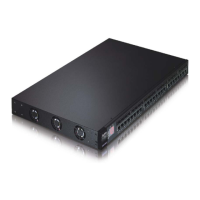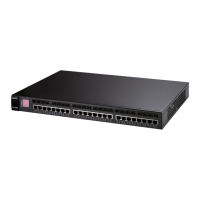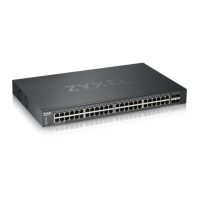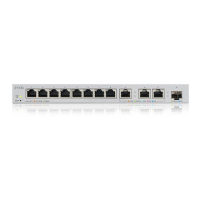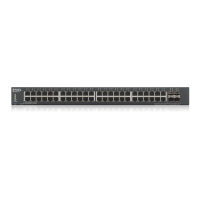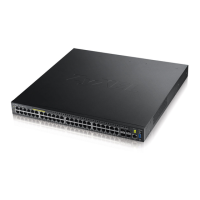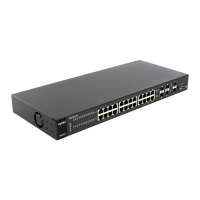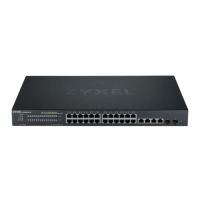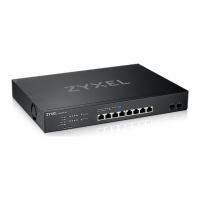
Do you have a question about the ZyXEL Communications XGS2210-52HP and is the answer not in the manual?
| Switching Capacity | 176 Gbps |
|---|---|
| Humidity | 10% to 90% non-condensing |
| Management | Web-based GUI, CLI, SNMP |
| Product Type | Managed Switch |
| Layer | Layer 2 |
| Ports | 48 x 10/100/1000 Mbps ports, 4 x 10G SFP+ uplink ports |
| PoE | Yes |
| Forwarding Rate | 130.9 Mpps |
| MAC Address Table | 32K entries |
| Dimensions (W x D x H) | 440 x 44 x 44 mm |
| Power Supply | 100-240 V AC, 50/60 Hz |
| Operating Temperature | 0°C to 50°C |
| Storage Temperature | -40°C to 70°C |
| Jumbo Frame | 9216 bytes |
Guides users through the process of accessing the Switch's web configurator using default credentials.
Provides a tutorial on configuring DHCPv4 snooping to assign IP addresses and manage VLANs.
Guides users on configuring the Switch to forward DHCP client requests to a specific DHCP server.
Details configuration of Switch IP address, default gateway, and management VLAN ID for network access.
Explains how to configure individual Switch port settings like speed, duplex, and flow control.
Covers PoE status and configuration for PoE models, including power allocation and priorities.
Provides screens to view IPv6 interface status and configure Switch's management IPv6 addresses.
Explains how to configure stacking to form a larger system, including status and configuration of stacked switches.
Details the steps to configure a static VLAN for the Switch, including port assignments and tagging.
Explains how to assign static MAC addresses for a port to reduce broadcasting needs and enhance security.
Details how to configure rules to forward specific multicast frames to specific port(s).
Guides users on creating rules for traffic filtering based on specified criteria.
Details how to configure RSTP settings for the Switch.
Explains how to configure MRSTP settings on the Switch.
Details how to configure MSTP settings on the Switch.
Guides users on setting up bandwidth limits for traffic flowing through the Switch's ports.
Details how to limit broadcast, multicast, and DLF packets per second on Switch ports.
Guides users on selecting a monitor port and specifying traffic flow to be copied to it.
Details how to configure static link aggregation and traffic distribution algorithms.
Guides users to activate port authentication methods and configure RADIUS server settings.
Details how to activate IEEE 802.1x security on the Switch and its ports.
Explains how to activate MAC authentication on the Switch and configure it on each port.
Guides users on enabling port security and disabling MAC address learning.
Details how to define or view a schedule on the Switch for time-based feature activation.
Explains how to define classifiers and specify actions (policy) for traffic matching the rules.
Guides users on configuring policy rules after defining classifiers, specifying actions for traffic flows.
Details how to set priorities for queues to distribute bandwidth across different traffic queues.
Details configuration of RADIUS server settings for authentication and accounting.
Explains TACACS+ server configuration for authentication and accounting settings.
Covers specifying authentication methods, authorization settings, and accounting configurations.
Details current bindings for DHCP snooping and ARP inspection, learned dynamically or manually.
Guides users on managing static bindings for DHCP snooping and ARP inspection by MAC address and VLAN ID.
Details enabling DHCP snooping, specifying trusted ports, and configuring the database.
Specifies whether ports are trusted or untrusted for DHCP snooping and sets packet rate limits.
Enables DHCP snooping on each VLAN and specifies whether to add DHCP relay agent option 82 information.
Details enabling ARP inspection, configuring filter aging time, and log settings.
Specifies whether ports are trusted or untrusted for ARP inspection and sets packet rate limits.
Guides users on manually creating IPv6 source guard binding table entries.
Allows configuring policies to forward valid IPv6 addresses/prefixes and manage link-local traffic.
Details applying configured IPv6 source guard policies to specified ports.
Guides users on enabling loop guard on the Switch and specific ports.
Details how to enable layer 2 protocol tunneling on the Switch and specify encapsulation MAC address.
Guides users on configuring sFlow by selecting ports and setting sample rates.
Explains configuring the Switch to provide subscriber information to PPPoE servers.
Specifies whether individual ports are trusted or untrusted for PPPoE discovery packets.
Details PPPoE IA settings that apply to a specific VLAN on a port.
Displays detected control packet rate limit exceedances and port status.
Limits control packets (ARP, BPDU, IGMP) received or transmitted on a port.
Configures detection of control packet rate limit exceedance and the action to take.
Sets the Switch to automatically undo actions after the error condition is resolved.
Guides users on enabling MAC pinning on the Switch and specific ports.
Details how to set up port isolation within a VLAN, specifying promiscuous and isolated ports.
Guides users on configuring Green Ethernet settings globally and per port.
Guides users on configuring global LLDP settings, including transmit intervals and delays.
Enables Anti-Arpscan, sets port/host thresholds, and configures ports as trusted or untrusted.
Details configuring and enabling IPv4 static routes for destination IP addresses and subnet masks.
Explains configuring and enabling IPv6 static routes for destination IPv6 addresses and prefix lengths.
Details configuring DSCP to IEEE 802.1p mapping for prioritizing traffic based on DSCP values.
Details configuring DHCP relay for clients not in the same broadcast domain as the server.
Details configuring global DHCPv4 relay settings for the Switch.
Provides access to screens for setting ARP learning mode and creating static ARP entries.
Guides users on creating static ARP entries that do not age out in the ARP table.
Explains how to save current configuration settings permanently to Configuration 1, 2, or Custom Default.
Details how to upgrade the Switch to the latest firmware using dual firmware images.
Details how to configure SNMP settings, including version, community strings, and trap destinations.
Details how to ping IP addresses, run traceroutes, perform port tests, and show Switch location.
Guides users on configuring system logging settings and external syslog servers.
Details how to configure clustering management, including activating the cluster manager and adding members.
Displays port statistical summaries with links to detailed performance data.
Addresses issues like the Switch not turning on or LEDs behaving unexpectedly.
Covers common login problems, such as forgetting IP address, username, or password.

